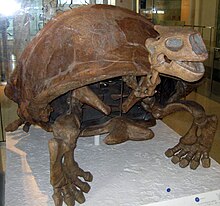


The Sivalik Hills, also known as the Shivalik Hills and Churia Hills, are a mountain range of the outer Himalayas. The literal translation of "Sivalik" is 'tresses of Shiva'.[1] The hills are known for their numerous fossils, and is also home to the Soanian Middle Paleolithic archaeological culture.[2]

The Sivalik Hills are a mountain range of the outer Himalayas that stretches over about 2,400 km (1,500 mi) from the Indus River eastwards close to the Brahmaputra River, spanning the northern parts of the Indian subcontinent. It is 10–50 km (6.2–31.1 mi) wide with an average elevation of 1,500–2,000 m (4,900–6,600 ft). Between the Teesta and Raidāk RiversinAssam is a gap of about 90 km (56 mi).[3] They are well known for their Neogene and Pleistocene aged vertebrate fossils.[4]
Geologically, the Sivalik Hills belong to the Tertiary deposits of the outer Himalayas.[5] They are chiefly composed of sandstone and conglomerate rock formations, which are the solidified detritus of the Himalayas[5] to their north; they are poorly consolidated. The sedimentary rocks comprising the hills are believed to be 16–5.2 million years old.[6]
They are bounded on the south by a fault system called the Main Frontal Thrust, with steeper slopes on that side. Below this, the coarse alluvial Bhabar zone makes the transition to the nearly level plains. Rainfall, especially during the summer monsoon, percolates into the Bhabar, then is forced to the surface by finer alluvial layers below it in a zone of springs and marshes along the northern edge of the Terai or plains.[7]

The Sivalik Hills are well known for fossils of vertebrates, spanning from the Early Miocene, until the Middle Pleistocene, around 18 million to 600,000 years ago.[8][9]
Some of the best known fossils from the hills include Megalochelys atlas, the largest known tortoise to have ever existed,[10] Sivatherium giganteum, the largest known giraffid, [11] and the ape Sivapithecus.[12]
Remains of the Lower-Middle Paleolithic Soanian culture dating to around 500,000 to 125,000 years Before Present were found in the Sivalik region.[13] Contemporary to the Acheulean, the Soanian culture is named after the Soan Valley in the Sivalik Hills of Pakistan. The Soanian archaeological culture is found across Sivalik region in present-day India, Nepal and Pakistan.[2]
27°46′N 82°24′E / 27.767°N 82.400°E / 27.767; 82.400
|
Geography of South Asia
| |
|---|---|
| Mountains |
|
| Plateaus |
|
| Deserts |
|
| Lowlands |
|
| Coasts |
|
| Islands |
|
| By country |
|
| Byregion |
|
|
| |||||||||||||||||||
|---|---|---|---|---|---|---|---|---|---|---|---|---|---|---|---|---|---|---|---|
State capitals: legislative: Dehradun (winter); Bhararisain (summer); judicial: Nainital | |||||||||||||||||||
| Government |
| ||||||||||||||||||
| History |
| ||||||||||||||||||
| Geography and ecology |
| ||||||||||||||||||
| Demographics |
| ||||||||||||||||||
| Administrative divisions |
| ||||||||||||||||||
| Politics |
| ||||||||||||||||||
| Tourism |
| ||||||||||||||||||
| Sports |
| ||||||||||||||||||
| Other topics |
| ||||||||||||||||||
| Districts |
| ||||||||||||||||||
| Major cities |
| ||||||||||||||||||
| International |
|
|---|---|
| National |
|